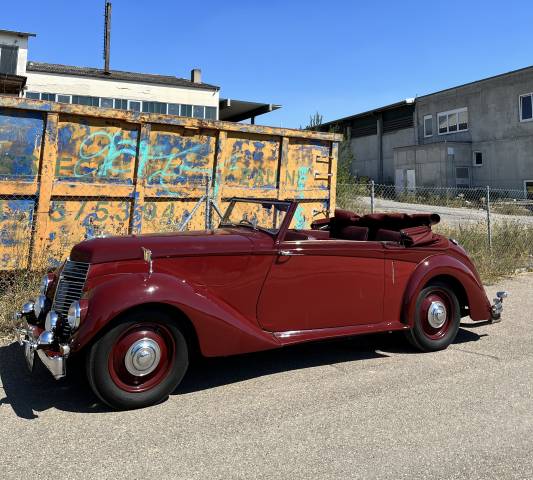- Car
- Armstrong-Siddeley
- Armstrong-Siddeley Hurricane (0 offers)
Armstrong-Siddeley Hurricane Classic Cars for Sale
The Armstrong-Siddeley Hurricane Cabriolet stands out with its rare combination of aluminium-over-ash frame construction, suicide doors, and a robust six-cylinder engine. Produced between 1946 and 1953 in strictly limited numbers, this sophisticated convertible blends British craftsmanship with subtle technical innovation.
Search results
Currently, there are no matching listings for your search.
Create search alert
Let yourself be notified as soon as a listing is published that matches your search filters.
Create listing
Do you have a Armstrong-Siddeley Hurricane that you want to sell? Then create a listing now.
Create listingArmstrong-Siddeley Hurricane listing references from Classic Trader
Below you will find listings related to your search that are no longer available on Classic Trader. Use this information to gain insight into availability, value trends, and current pricing for a "Armstrong-Siddeley Hurricane" to make a more informed purchasing decision.

1946 | Armstrong-Siddeley Hurricane
Deutsche Zulassung,H-Kennz.,vor einigen Jahren restauriert

1947 | Armstrong-Siddeley Hurricane
Create search alert
Let yourself be notified as soon as a listing is published that matches your search filters.
Create listing
Do you have a Armstrong-Siddeley Hurricane that you want to sell? Then create a listing now.
Create listingHistory of the Armstrong-Siddeley Hurricane
Following the end of World War II, Armstrong-Siddeley introduced the Hurricane as a high-end cabriolet, evolving from the chassis concept of the Lancaster and succeeding the 16-Six. The Hurricane was produced exclusively as a two-door, four-seater soft-top, utilising a combination of ash timber and aluminium bodywork—a hallmark of British coachbuilding of the era. In total, 2,606 Hurricanes were built over seven years, with minimal model changes except for a lowered bonnet line and stone guards introduced in the 1948 version. The Hurricane’s entire production run was brief, ending in 1953, after which no direct successor was released.
Model History
Engineered upon the Armstrong-Siddeley Lancaster underpinnings, the Hurricane carries forward the legacy of the 16-Six and adopts many of its technical concepts, such as independent front suspension and a robust Girling braking system. Initial versions came with a 2.0-litre six-cylinder, but the model was quickly upgraded in 1949 to a 2.3-litre engine. Alongside the core convertible, export-oriented body types such as the Utility Coupe and Station Coupe emerged for markets like Australia, with production figures for these rarities remaining below 1,100 units combined. The Hurricane’s limited run ended in 1953 with no replacement, marking it as the closing chapter of Armstrong-Siddeley’s classic cabriolets.
Highlights and Distinctive Features
The Hurricane’s aluminium-clad, ash wood frame structure is a technical highlight, as are the signature rear-hinged 'suicide' doors. Early adoption of a part-hydraulic Girling brake system and torsion bar front suspension delivered notable advancements for the post-war market. Seating was designed for four, with practicality prioritised even in export models such as the Station Coupe, which offered additional cabin space for the Australian market. Given a production share of 100% among Armstrong-Siddeley listings on our platform, the Hurricane remains the sole representative of the brand in this segment, reflecting its unique standing and rarity today.
Technical Data
Special Editions and Collectible Variants
Export-focused models like the Utility Coupe and Station Coupe, built primarily for Australia (comprising 60% of total production), hold special interest for collectors due to their unique body layouts—longer load beds for work utility, double cabs for passenger capacity, and limited production numbers (just 1,022 units). These variants often carry the rarer right-hand drive configuration and are rarely seen on the market.
Weak Spots and Common Issues
No specific recurring issues are reported for the Hurricane in the current data. However, the unique construction—ash frame overlaid with aluminium—demands careful periodic internal inspection for wood degradation or corrosion where wood and metal meet. Door geometry (especially with suicide doors) should be examined for proper alignment, and the Girling semi-hydraulic brakes require attentive servicing due to their mixed hydraulic and mechanical layout.
Engine and Performance, Transmission and Handling
The Hurricane’s straight-six engine, initially 2.0 litres and increased to 2.3 litres, delivers smooth, torque-rich performance for leisurely touring, supported by a choice between a classic four-speed manual or pre-selector gearbox. Independent front suspension with torsion bars contributes to stable handling and relative ride comfort. The mixed brake technology, featuring hydraulics up front and cables at the rear, provides adequate stopping power by period standards but demands modern awareness in traffic. Notable engines include the 2.3-litre 18 hp variant fitted to Station and Utility Coupes for the Australian export market, pairing robust low-end torque with a reputation for reliability.
Interior, Comfort, Exterior and Design
The Hurricane’s visual character is defined by its long, flowing firewall, distinctive rear-hinged doors, and hand-finished convertible bodywork in aluminium over a traditional ash frame. The refined British interior seats four, although the Station Coupe variant offers limited rear-seat space. Materials and finishes reflect the understated luxury expected in upmarket post-war UK vehicles, with factory-fitted disc wheels and minimalist chrome accents. Export variants sometimes featured tailored trim or utility enhancements for the Australian market. Accessories and special equipment were tailored to order, reflecting the bespoke approach of Armstrong-Siddeley during this era.
Further Noteworthy Aspects
Roughly 60% of all Station Coupe/Utility Coupes were exported to Australia, making right-hand drive versions particularly prominent among survivors. Most Hurricanes remain rare, with very few entering the open classic car market each year—underscoring their low supply.
Summary
The Armstrong-Siddeley Hurricane occupies a niche as a post-war British cabriolet that combines hand-built craftsmanship, moderate technical innovation, and export-oriented versatility. With only 2,606 made and a high proportion sent overseas, especially to Australia, the Hurricane presents a scarcity matched by few contemporaries. Anyone considering a purchase should weigh the vehicle’s unique wood-and-aluminium construction, low total production, and distinct export variants—all factors making this a noteworthy addition to any classic car collector’s garage.